Abstract
Most forest harvesting operations are performed using two or more forestry machines in combination; in the typical forest production system in steep terrain in Japan, there are four production processes: felling, yarding, processing, and forwarding. It is essential to evaluate the overall productivity of such combined production systems, but the calculation method that indicates the productivity has not been fully established. In this study, we built simulation models of serial, parallel, and sequential production systems by using system dynamics to evaluate their productivity regarding the combined machine productivity (CMP) and combined labor productivity (CLP) indices. Comparing the three types of forest harvesting systems in Japan, the parallel production system had the highest CMP, while the serial production system had the highest CLP; the sequential production system lay between the serial and parallel production systems in terms of CMP and CLP. The overall productivity of Japanese forest production systems was lower than that of Central Europe, where processor tower yarders (PTYs) are used. Thus, the CLP of Japanese forest production systems was improved by 12.8 to 26.5% by incorporating the concept of a PTY, and it can be further improved by eliminating the forwarding process.
1. Introduction
Maximizing machine productivity is a critical aspect of planning for timber harvesting in forests [1]. Today, most forest harvesting operations are performed with modern forestry machines, and their efficiency depends not only on the performance of each forestry machine but also on how they are used in combination and on various site characteristics [2]. The term “system productivity” has been used since the late 1990s to describe the overall productivity of a production process with several production elements or forest harvesting systems using several forest machines in combination [3,4,5,6,7,8,9], but the term is not clearly defined, and its calculation methods remain ambiguous. As for its units, a clear definition was proposed in the recent literature [10]. Since time is the basic physical unit of characterizing resource consumption, a useful approach to specifying time is to use the three dimensions of (1) time category, (2) study object, and (3) time unit [10]. The first dimension is the time category (P = productive, I = indirect, U = unproductive), the second dimension is the entity of interest (P = personnel, M = machine, S = system), and the third dimension is the physical unit of time (D = day, H = hour, S = second) [10]. According to this rule, the productive system hour (PSH) must be used for systems consisting of several machines, while the productive machine hour (PMH) is widely used for systems consisting of a single machine and an operator [10]. Similarly, the scheduled machine hour (SMH) is used for the operation of each machine and operator, and the scheduled system hour (SSH) is used for the operation of a multi-machine system.
In our previous study [2], we presented the methods of calculating the combined machine productivity (CMP) and combined labor productivity (CLP), which indicate the production speed and labor productivity, respectively, to evaluate the system productivity of forest harvesting systems using a combination of forestry machines in steep terrain, where the cut-to-length (CTL) system cannot be used and cable systems are more common due to the slope. This study aimed to evaluate the system productivity of such forest harvesting systems by using a computer simulation to flexibly calculate the CMP and CLP based on the performance of the combined forestry machines and the type of combination.
Simulation-based systems are used to analyze discrete and complex real-world situations that cannot be solved by analytical, operational research methods due to the various interactions among system components [11]. Another advantage of modeling is that it does not disrupt the actual workflow, and different decision scenarios can be tested [11]. Thus, computer simulation is one of the best methods for analyzing timber harvesting operations [12], and it is a way to avoid disrupting a logging operation and evaluate different system configurations [13]. Many studies have used computer simulations to evaluate the productivity of forest harvesting systems. In the late 1960s, computer simulation models of logging machinery were introduced as a tool for evaluating forest machine concepts [14]. Increasing computing power and the availability of more sophisticated methods led to a boom in system analysis and operation research methods related to forest operations [15], and numerous studies have been conducted in this area to date.
The following studies of forest production systems using computer simulation were conducted up to the year 2000. A simulation model for harvesting pulpwood with a feller-buncher was developed to test the effect on operating speeds, minimum and maximum radii of sweep or boom reaches, strip widths, spatial pattern, and the number of trees per acre on harvesting time [16]. A harvesting simulator with a three-part system for modeling the environment, individual machine activities, and harvesting system interactions was developed and used to verify its performance in timber harvesting analysis [17]. A discrete event simulation (DES) model of a mechanized forest harvesting system was evaluated, emphasizing the effectiveness of using statistical distributions derived from field study data as input [18]. A ground-based harvesting system simulation model (GB-SIM) was developed to estimate stump-to-truck production rates and multi-product yields for conventional ground-based harvesting systems in Appalachian hardwood stands [19]. A simulation program was developed using the general purpose simulation system (GPSS) language to determine the optimal combination and relative location of a tower yarder, processor, and skidder in terms of productivity [20,21,22]. A computer simulation for yarding was developed using an object-oriented model to estimate the operational efficiency, which was estimated to be within only 4.9% of the actual measurements [23]. An interactive computer simulation was developed to model the stand, harvest, and machine factors and to evaluate their interactions during felling, skidding, or forwarding operations [24,25]. A simulation model of a single-grip harvester was developed to evaluate different silvicultural treatments and to compare different machine concepts with minimum confounding factors [14].
Between 2000 and 2009, the following studies were conducted on forest production systems using computer simulation. The optimal length of skidding roads to minimize costs for forest harvesting systems with a tower yarder, processor, and forwarder was determined using simulation models, including the number of operators and other factors [26]. The harvesting system assignment model was developed using system dynamics simulation to simulate the four common types of ground-based logging systems found in the southeastern United States to determine the production potential of a given stand [27,28]. A commercially available simulation program was used to manage the timber supply chain and optimize timber harvesting as a first step toward computer-based improvements in forest management for precision forestry [11]. The production of ground-based timber harvesting systems was estimated using object-oriented modeling techniques that generated stands of trees, simulated chainsaw, drive-to-tree feller-buncher, swing-to-tree single-grip harvester felling, and grapple skidder and forwarder extraction activities, and costs and productivity were analyzed [12]. CTL harvesting systems involving small and large harvesters and a forwarder were simulated using a modular computer simulation model, and regression equations were developed to estimate productivity and costs for the range of conditions simulated [29]. A method of representing forest operations within a system dynamics model using the transition probabilistic concept of elemental work was presented, and its potential was discussed [30]. Forest harvesting operations in Japan, including road construction, felling, grappling, processing, and forwarding trees, were modeled, and their labor productivity was estimated using system dynamics simulation [31]. A new ground-based harvesting system for efficiently harvesting slash and small trees for biomass energy was proposed and validated using system dynamics simulation [32]. Furthermore, some new concepts of cable harvesting systems, i.e., gondola cable, draw well, double track, and double carriage systems, were designed and validated using system dynamics simulation [33].
The following studies of forest production systems using computer simulation were conducted in the 2010s. Operating time, cost, and productivity were evaluated using system dynamics simulation and compared between combined and independent harvesting systems [34]. A DES technique was used to compare an integrated system that simultaneously harvests stems and stump centers with a conventional system that harvests stems and stumps separately in terms of productivity and cost [35]. An agent-based computer simulation model was developed to compare system productivity in different wood extraction and processing practices [13,36]. A DES technique was used to recreate an excavator-based integrated yarder–processor and then tested under different forest conditions and work configurations, and the benefits of a fully integrated yarder-processor were evaluated against the alternative of splitting the yarding and processing functions into two base machines [7]. A DES technique was used to model a ground-based timber harvesting system, and the DES results were compared with those of the time study model developed with the same observed data; it was suggested that the DES approach may become an appropriate method for analyzing complex systems, especially when the interactions between different machine processes are unknown [8].
From 2020 to the present, the following studies of forest production systems have been conducted using computer simulation. An agent-based simulation model was developed to simulate whole tree yarding and processing with cable yarders and the subsequent transportation of the harvested wood to sawmills, paper mills, or heating plants [37]. A DES model of a harvester was developed to assess the productivity of multiple working methods in an array of stand characteristics and to quantify the productivity gains of adapting the operator’s working method to the stand [38]. To increase harvester productivity and reduce the thinning costs of young forest stands, a new thinning method, boom-corridor thinning, was developed, and an agent-based simulation model was used to validate this method by simulating harvester movement in the stand [39]. A simulation of productivity and fuel consumption in skidding operations was carried out for a wide range of extraction distances, and the results indicated that shortening the extraction distances may be the best option for improving operational and environmental performance [40]. A simulation model was developed to analyze the performance and profitability of strip harvesting brushwood/young trees under different conditions in terms of stem density, the average and spread of diameter at breast height (DBH), tree species, biomass yield, and spatial aspects such as the length and depth of strips [41]. A study was conducted to determine whether the inherent attributes of mechanized timber harvesting in Eucalyptus spp. plantations allow the creation of a high-performance model that can accurately predict productivity using machine learning [1].
Among the above methods, there are mainly three computer simulation methods commonly used for modeling different levels of abstraction: system dynamics, discrete events, and agent-based modeling [13]. We used system dynamics simulation to evaluate the productivity of the typical forest harvesting system in Japan and compared it with that of the processor tower yarder (PTY) system, which is mainly used in Central Europe and integrates the drums, a steel spar, a power supply, a boom, and a processor head on a carrier [42]. The advantage of system dynamics simulation is the ability to build models with feedback loops in many areas, such as business, environment, and human society, without any programming knowledge or skills, to track the system behavior over time, and to help us understand the simulation results by visualizing them. The objective of this study was to identify the advantages and disadvantages of different types of forest harvesting systems, not to determine the exact productivity, through system dynamics simulation. Therefore, we evaluated the productivity of forest harvesting systems in Japan compared with those in Central Europe and proposed and validated several ways to improve system productivity.
2. Materials and Methods
2.1. Classification of Production Models
In our previous study [2], forest harvesting systems were classified into two types: serial and parallel production systems. On the other hand, in this study, forest harvesting systems were classified into three types: serial, parallel, and sequential. The schematic diagrams of these production systems are shown in Figure 1, where process C is the fastest, followed by process A, while process B is the slowest.
2.1.1. Serial Production System
In the serial production system, the production processes run in sequence, as shown in Figure 1a. In this figure, process B starts after process A is completed, and similarly, process C starts after process B is completed. This means that the storage capacity in each production process must be equal to or larger than the total volume of logs processed. Otherwise, the serial production system will not function, and a parallel or sequential production system must be selected instead.
2.1.2. Parallel Production System
In this study, the parallel production system is defined differently from our previous study [2], and all production processes run in parallel. As shown in Figure 1b, all production processes run in parallel during the period of the rate-limiting or slowest process B, and process C runs slower than its original rate to match the rate of process B. This means that the system productivity of the parallel production system becomes equal to the productivity of the rate-limiting or slowest process.
2.1.3. Sequential Production System
The sequential production system was not defined and used in our previous study [2]. In this study, it is set as an intermediate between the serial and parallel production systems. As shown in Figure 1c, process B starts when the storage capacity in process A is full, and similarly, process C starts when the storage capacity in process B is full. This production system is a viable option when the storage capacity in each production process is limited, and the serial production system cannot be chosen.
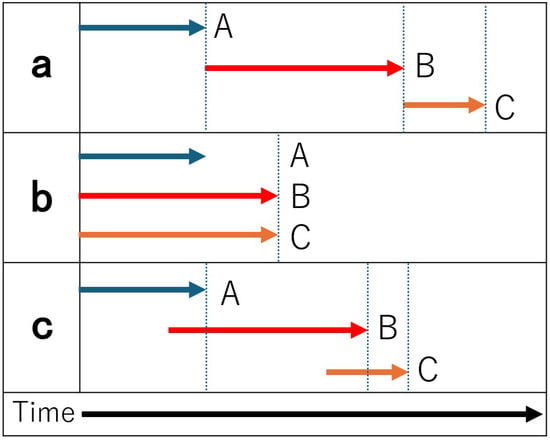
Figure 1.
Schematic diagrams of (a) serial, (b) parallel, and (c) sequential production systems.
2.2. Modeled Production Systems
The typical forest harvesting system in Japan has four production processes: felling, yarding, processing, and forwarding using a chainsaw, swing yarder, processor, and forwarder, respectively (Figure 2). According to the Forestry Agency [43], the number of swing yarders, tower yarders, processors, harvesters, and forwarders in Japan in the fiscal year 2022 was 1134, 152, 2256, 2101, and 3651, respectively. Swing yarders in Japan are hydraulic excavators with attached winches, and such excavator-based yarders have been used in Japan since the early 1990s [44,45]. Today, swing yarders are much more common than tower yarders in Japan because they are multi-purpose machines that can be used as excavators or loaders, and such machines are easy to introduce to small or medium-sized forestry enterprises [46] as the relatively low investment in build-on yarding equipment allows for lower levels of annual utilization and seasonal activity [47]. In this respect, Japanese swing yarders can be considered analogous to European tractors that are used for both forestry and agriculture by changing attachments [46]. However, the productivity of yarding operations with a swing yarder in Japan is quite low compared with that in Europe because most Japanese swing yarders use the simple two-line running skyline system. The low productivity of Japanese swing yarders is due to their difficulty in lateral yarding, insufficient tractive force [48] due to the lack of guylines [47,49], and the additional cycle time added when self-rotating to place a whole tree on the forest road [48]. Similarly, most Japanese processors and harvesters are also hydraulic excavators with a processor or harvester head, and most harvesters are used as processors at the landing. This type of processor is also used at cable yarder landings and was studied in Europe; an excavator with a processor head working at the landing, coupled with a cable yarder used to extract the felled trees, is a valuable solution for improving productivity [50]. Japanese forwarders often perform relay hauling of logs on spur roads instead of collecting them in the CTL system, and the standard maximum load capacity for forwarders in Japan is about 3000 to 6000 kg. The forwarding process adds to the number of production processes that affect the overall productivity of forest harvesting systems in Japan.
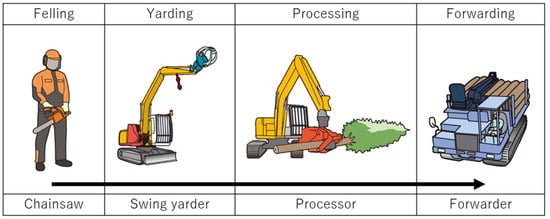
Figure 2.
Typical forest harvesting system in Japan.
We compared the typical forest harvesting system in Japan with the PTY system mainly used in Central Europe (Figure 3), which has two production processes, felling and yarding/processing using chainsaws and PTYs, respectively. The PTY system has undergone continuous development since 1994 when Mayr-Melnhof attached the operator’s cabin to the boom, providing the operator with optimum visibility and working conditions, and the turntable on which the steel spar and winches were mounted in its Syncrofalke [42]. By the end of the 1990s, PTYs with radio-controlled carriages and automatic carriage movement and stopping became standard for all manufacturers in Central Europe [42]. Today, PTYs are the most successful and mature technology in the field of cable yarding systems for steep terrain, and their productivity has been evaluated and validated mainly in Europe [51,52,53,54].
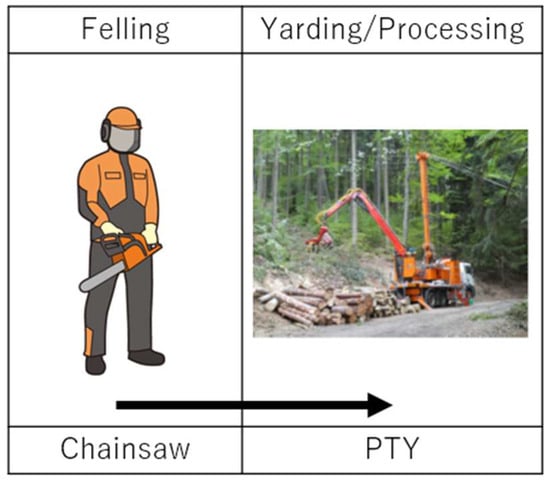
Figure 3.
Forest harvesting system with a processor tower yarder (PTY) in Central Europe.
Figure 4 compares the forest harvesting systems between Japan and Central Europe. As shown, the PTY system in Central Europe is obviously simpler than the Japanese forest harvesting system, with fewer forestry machines and production processes. In Japan, the construction and maintenance of spur roads is time-consuming and costly, and the distance of timber transportation on a winding spur road is significantly longer than on a straight cable line. In addition, the Japanese forest harvesting system requires logs to be transferred from forwarders to trucks at the landing, as shown in Figure 4.
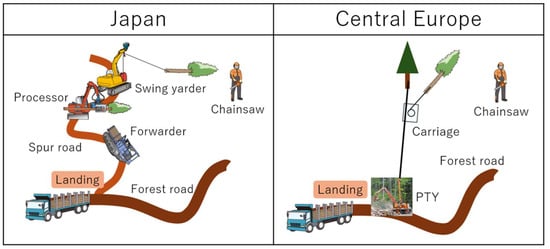
Figure 4.
Comparison of forest harvesting systems between Japan and Central Europe.
2.3. Productivity Evaluation
We used the system dynamics software Stella Architect 3.7.3 (isee systems, Lebanon, NH, USA) to evaluate and compare the productivity of serial, parallel, and sequential production systems. This is a visual diagram-based simulation software that helps us understand the behavior of complex systems over time. Figure 5 illustrates the four basic building blocks used in this software, i.e., stock, flow, converter, and connector, whose definitions are shown in Table 1. We developed system dynamics simulation models for forest harvesting systems, which are typically used in Japan and Europe. Table 2 shows the performance values of forestry machines in Japan and Central Europe, which were determined based on the published literature in our previous study [2]. It should be noted that the performance values of the forestry machines shown in Table 2 can be changed to any value if necessary to perform the system dynamics simulation.
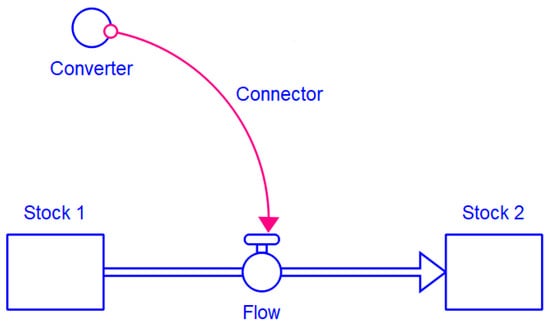
Figure 5.
Four basic building blocks used in the Stella Architect software.

Table 1.
Four basic building blocks used in the Stella Architect software.

Table 2.
Performance values of forestry machines used in Japan and Central Europe for system dynamics simulation.
2.4. Combined Machine Productivity (CMP) Calculation
The CMP for the serial production system was calculated using the following equation [2]:
where CMP is the combined machine productivity (m3/h), and Pi is the production rate (m3/h) in the production process i (i = 1; n, where n is the total number of production processes). For the serial production system, m3/PSH and m3/PMH can be used as the unit of productivity for CMP and Pi, respectively, instead of the unit of m3/h, provided that mechanical and non-mechanical delays are not included. On the other hand, for the parallel and sequential production systems, where delays due to waiting for another phase of an integrated operation are usually included as non-mechanical delays, m3/SSH and m3/SMH can be used as the unit of productivity for CMP and Pi, respectively, instead of the unit of m3/h.
The CMP for the parallel production system is equal to the rate-limiting or slowest process rate, defined differently from our previous study [2]. The CMP for the sequential production system depends on the storage capacity of each production process and can be determined not by Equation (1) but by system dynamics simulation.
2.5. Combined Labor Productivity (CLP) Calculation
The CLP for the serial production system was calculated by the following equation [2]:
where CLP is the combined labor productivity (m3/worker/h), Pi is the production rate (m3/h) in the production process i (i = 1; n, where n is the total number of production processes), and Ni is the number of workers in the production process i. Equation (2) can be applied to all types of production systems, such as serial, parallel, and sequential. For the serial production system, m3/worker/PSH and m3/worker/PMH can be used as the unit of productivity for CLP and Pi/Ni, respectively, instead of the unit of m3/worker/h, provided that mechanical and non-mechanical delays are not included. On the other hand, for the parallel and sequential production systems where delays due to waiting for another phase of an integrated operation are usually included as non-mechanical delays, m3/worker/SSH and m3/worker/SMH can be used as the unit of productivity for CLP and Pi/Ni, respectively, instead of the unit of m3/worker/h.
2.6. Storage Capacity
As for storage capacity, it is assumed to be unlimited in the felling process because whole felled trees can be left and stored on mountain slopes until the yarding process starts. In the Japanese forest harvesting system, the storage capacity in the yarding process is assumed to be zero because whole trees cannot be stored due to the limited space on the spur road. In contrast, the storage capacity in the processing process for the sequential production system is assumed to be 20 m3 for short logs converted from whole trees, which is approximately equivalent to four times the transportation of a 5-ton forwarder. Until a forwarder loads these short logs, they are stacked on the spur road, sometimes requiring extra roadside storage space.
2.7. Additional Conditions
In this study, the CMP and CLP were calculated for the serial, parallel, and sequential production systems in Japan. It should be noted that the simulation did not consider log truck transportation; log trucks were assumed to arrive in time to pick up logs when the landing was full. The indices were also calculated for the serial and parallel production systems in Central Europe but not for the sequential production system because it is assumed that the storage capacity in all stocks is unlimited; thus, there is no need to adopt a sequential production system. In all simulation models, the log-based volume was used for all production processes, including standing trees, and the initial volume of standing trees was set to 300 m3.
3. Results
3.1. Serial Production System in Japan
Figure 6 shows a system dynamics model for the serial production system in Japan, constructed using Stella Architect software, where the storage capacity in each stock was assumed to be at least 300 m3, which was the initial volume of standing trees. The variation in the log volume of each stock as a function of elapsed time is shown in Figure 7. In this production system, the total production time was 258 h, and the CMP and CLP were calculated as 1.16 m3/h and 0.86 m3/worker/h, respectively, using Equations (1) and (2).

Figure 6.
A system dynamics model for the serial production system in Japan.

Figure 7.
Variation in the log volume of each stock for the serial production system in Japan.
3.2. Parallel Production System in Japan
Figure 8 shows a system dynamics model for the parallel production system in Japan, where the storage capacity in the stock of yarded trees was assumed to be zero due to the limited space on the spur road. The variation in the log volume of each stock as a function of elapsed time is shown in Figure 9. In this production system, the production rates of felling, yarding, processing, and forwarding were 4.15, 3.24, 3.24, and 3.24 m3/h, respectively, instead of the original process rates of 4.15, 3.24, 7.32, and 5.89 m3/h, respectively, due to the rate-limiting process of yarding. The time consumption of the excavator-based processor was closely linked to the overall time consumption of the cable yarder, resulting in significant delays for the processor [50]. These delays are primarily due to waiting for loads to arrive at the landing before processing operations can begin [50]. However, the CMP can still be significantly improved by parallelizing the production process. As a result, the total production time was 93 h, which is only 36.0% of the total production time of the serial production system in Japan. The CMP was 3.24 m3/h, which is equal to the production speed of the yarding process, and the CLP was calculated as 0.68 m3/worker/h using Equation (2).

Figure 8.
A system dynamics model for the parallel production system in Japan.
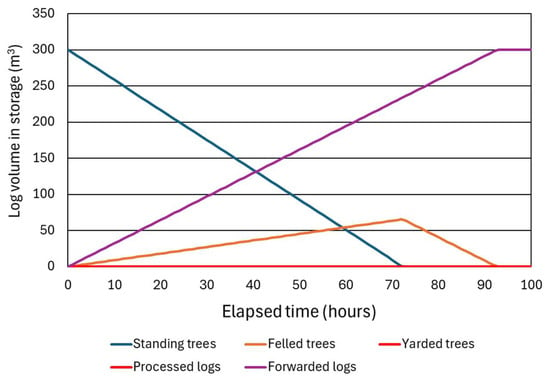
Figure 9.
Variation in the log volume of each stock for the parallel production system in Japan.
3.3. Sequential Production System in Japan
Figure 10 shows the system dynamics model for the sequential production system in Japan, and the variation in the volume of each stock as a function of the elapsed time is shown in Figure 11. The results of the system dynamics simulation show that the total production time was 166 h, which is 64.3% of the total production time of the serial production system in Japan. The CMP was calculated as 1.81 m3/h, and the CLP was calculated as 0.69 m3/worker/h using Equation (2).
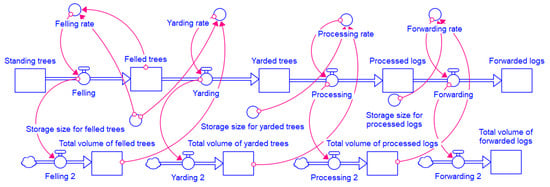
Figure 10.
A system dynamics model for the sequential production system in Japan.
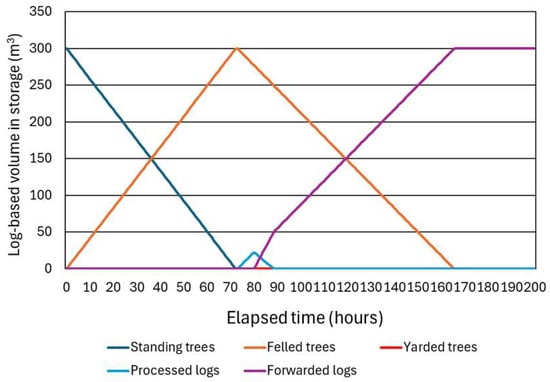
Figure 11.
Variation in the log volume of each stock for the sequential production system in Japan.
3.4. Serial Production System in Central Europe
Figure 12 shows the system dynamics model for the serial production system in Central Europe. The use of the serial production system is usually not possible in Japan because whole trees cannot be stored due to the limited space on the spur road. On the other hand, the use of PTYs in Central Europe is a perfect solution to this problem, as PTYs convert whole trees into short logs while a carriage moves back and forth. The variation in the volume of each stock as a function of elapsed time is shown in Figure 13. In this production system, the total production time was 66 h, and the CMP was calculated as 4.55 m3/h. The CLP was calculated as 3.26 m3/worker/h using Equation (2).

Figure 12.
A system dynamics model for the serial production system in Central Europe.

Figure 13.
Variation in the log volume of each stock for the serial production system in Central Europe.
3.5. Parallel Production System in Central Europe
Figure 14 shows the system dynamics model for the parallel production system in Central Europe. In this production system, the rate of the yarding/processing process was reduced to 7.50 m3/h because the rate of the felling process was slower than that of the yarding/processing process, as shown in Table 1. The variation in the volume of each stock as a function of elapsed time is shown in Figure 15. As a result, the total production time was 40 h, which is 60.6% of the total production time of the serial production system in Central Europe. The CMP was 7.50 m3/h, which is equal to the production speed of the felling process. The CLP was calculated as 2.50 m3/worker/h using Equation (2).

Figure 14.
A system dynamics model for the parallel production system in Central Europe.
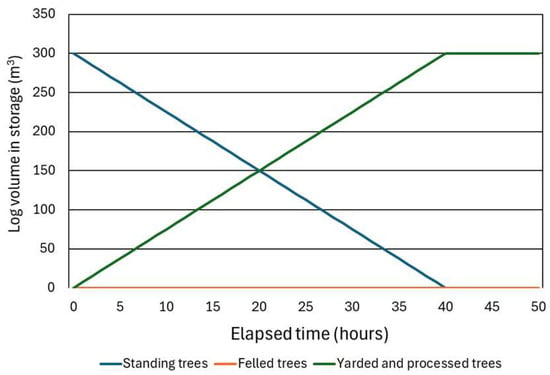
Figure 15.
Variation in the log volume of each stock for the parallel production system in Central Europe.
3.6. Productivity Comparison
Figure 16 and Figure 17 compare the CMP and CLP of all forest harvesting systems, respectively, in Japan and Central Europe. As shown, both CMP and CLP were much higher in Central Europe than those in Japan. When comparing the three types of production systems in Japan, the parallel production system had the highest CMP, while the serial production system had the highest CLP. The sequential production system lay between the serial and parallel production systems in terms of CMP and CLP. When comparing the two types of forest harvesting systems in Central Europe, the CMP for the parallel production system was higher than that of the serial production system, while the CLP for the serial production system was higher than that of the parallel production system.
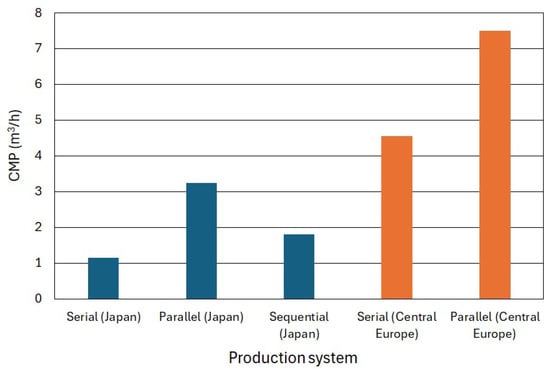
Figure 16.
Comparison of combined machine productivity (CMP) of all forest harvesting systems in Japan and Central Europe.
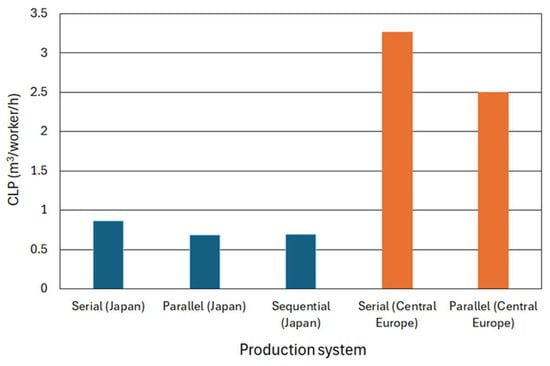
Figure 17.
Comparison of combined labor productivity (CLP) of all forest harvesting systems in Japan and Central Europe.
3.7. Productivity Improvement in Japan
We simulated an improved Japanese forest harvesting system by incorporating the concept of a PTY, which has a tower yarder and a processor on a carrier and saves one worker in the production process. As a result, the CMP values of the serial, parallel, and sequential production systems were 1.39 m3/h, 3.24 m3/h, and 1.81 m3/h, respectively, and improved by 19.8%, 0.0%, and 0.0%, respectively (Figure 18). The CLP values of the serial, parallel, and sequential production systems were 0.97 m3/h, 0.86 m3/h, and 0.87 m3/h, respectively, and improved by 12.8%, 26.5%, and 26.1%, respectively (Figure 19). This suggests that the advantage of PTYs is not that they integrate two production functions into one machine but that they reduce the number of workers.
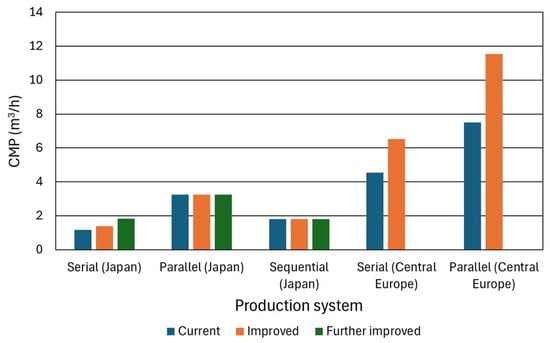
Figure 18.
Comparison between current and improved CMP of all forest harvesting systems in Japan and Central Europe.
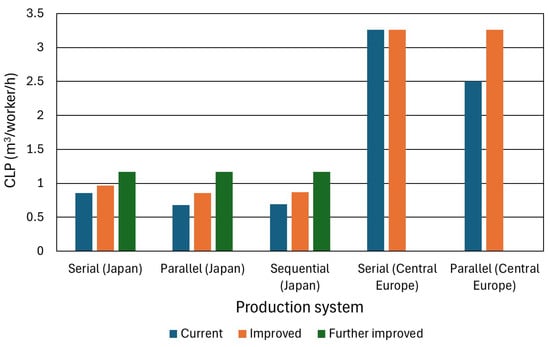
Figure 19.
Comparison between current and improved CLP of all forest harvesting systems in Japan and Central Europe.
To further improve the productivity of Japanese forest harvesting systems, we eliminated the forwarding process from the above production systems. In this case, a swing yarder and a processor must be placed on the forest road instead of the spur road. As a result, the CMP of the serial, parallel, and sequential production systems was 1.82 m3/h, 3.24 m3/h, and 1.81 m3/h, respectively, and improved by 56.9%, 0.0%, and 0.0%, respectively, from the current production systems (Figure 18). The CLP of the serial, parallel, and sequential production systems was 1.17 m3/h, 1.17 m3/h, and 1.17 m3/h, respectively, and improved by 36.0%, 72.1%, and 69.6%, respectively, from the current production systems (Figure 19).
In this study, the storage capacity was assumed to be only 20 m3, considering the conditions of the spur roads where the logs are stored. Figure 20 shows the variation in productivity according to the storage capacity in the processing process. The results show that the overall productivity, in terms of CMP and CLP, was highest when the storage capacity was 140 m3. When the storage capacity exceeded 140 m3, the CMP gradually decreased as the total production time increased. On the other hand, when the storage capacity exceeded 140 m3, the CLP remained at its maximum value because the forwarder no longer had to wait and could operate at full capacity.
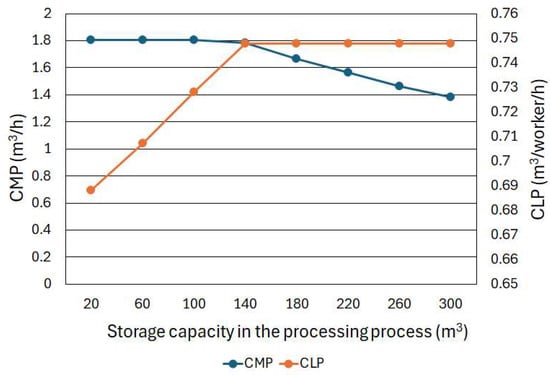
Figure 20.
Variation in CMP and CLP of the sequential production system as a function of the storage capacity in the processing process.
3.8. Productivity Improvement in Central Europe
To increase the CMP in Central Europe, two chainsaws and two operators could be used simultaneously in the felling process. As a result, the CMP of the serial and parallel production systems was 6.52 m3/h and 11.54 m3/h, respectively, an improvement of 43.3% and 53.9%, respectively (Figure 18). The CLP of the serial and parallel production systems was 3.26 m3/h and 3.26 m3/h, respectively, an improvement of 0.0% and 30.4%, respectively (Figure 19). We concluded that the CLP did not improve in the serial production system, but the CMP was improved by adding a worker to the felling process. We also concluded that both the CMP and CLP were improved in the parallel production system by adding a worker to the felling process.
4. Discussion
When two or more forestry machines are used in combination, it should be noted that improving the productivity of the rate-limiting or slowest production process is the most important step because the overall productivity in all forest production systems is always less than the productivity of the rate-limiting or slowest production process. This means that in the typical forest harvesting system in Japan, the productivity of the yarding process needs to be improved the most. Since Japanese swing yarders are equipped with only two drums, the simple two-line running skyline system is often used, which is less productive than the three-line (a skyline, a main line, and a haul back line) gravity system used in Central Europe. Using a cable system developed in Europe on an excavator-based yarder [55,56,57] could be a promising way to improve productivity in Japan. In addition, the production rates of all production processes in the parallel and sequential production systems should be balanced as much as possible.
Another way to increase the overall productivity of Japanese forest harvesting systems is to reduce the number of production processes, possibly to two, as in Central Europe. The effectiveness of two-process production systems is demonstrated by the high efficiency of the CTL system. The CTL system has two production processes, i.e., harvesting and forwarding, and its production speed is balanced at a high level. Most of the forest land in Japan is very steep; the percentage of forested areas with slopes of 30 degrees or more reached 36.3% of forest land [58], and CTL can be introduced in limited areas where slopes are gentle. In this sense, the introduction of PTYs in Japanese forestry should be considered to improve the overall productivity of the forest harvesting systems in Japan. When a PTY is used, a yarding/processing process can be carried out with only two workers, saving one worker from the typical Japanese production system. Although the PTY itself is incompatible with the size and strength of Japanese forest roads, it is possible to perform the same type of yarding and processing operations as a PTY system by using two forestry machines, a tower yarder and a processor [2]. Another option is to use an excavator-based yarder that integrates a tower yarder and a processor [6], which could be used under Japanese topographic and forest road conditions.
There is another way to improve the overall productivity of the typical forest harvesting system in Japan. This is to change the storage capacity in the processing process, where whole trees are converted into short logs for the sequential production system. The results show that the overall productivity, in terms of CMP and CLP, was highest when the storage capacity was increased from 20 m3 to 140 m3. This suggests that swing yarders should be placed on a relatively wide forest road or at the landing rather than on a spur road to provide more storage space for short logs.
In Central Europe, the use of PTYs, an automatic control device for moving and stopping the carriage, together with radio control, made it possible to operate a yarding/processing process with a crew of only two workers [42], which is advantageous in terms of labor productivity compared with three workers in Japan. The fact that whole trees can be processed while the carriage automatically moves back and forth is a very advantageous production system. On the other hand, there is still some imbalance between the yarding and processing functions of PTYs. When a tower yarder and processor were used in combination at the landing, the high incidence of delays in processing whole trees underscored the logistical challenges associated with coordinating extraction and processing operations in mountainous terrain, with a high correlation between delays due to waiting for incoming loads and yarding distance [50]. Eliminating these delays is an important issue even for PTYs that have a tower yarder and processor on a carrier.
There are potential limitations to this study. Although this study focuses on the most typical forest harvesting system for steep terrain in Japan, with four production processes, i.e., felling, yarding, processing, and forwarding using a chainsaw, swing yarder, processor, and forwarder, respectively, it does not cover all other forest harvesting systems. There are a variety of forest harvesting systems in Japan: (1) a dense network of spur roads is built and trees are collected using only grapple loaders, and (2) small-scale forestry, where a small winch is used to directly pull and collect trees. Further research is needed to cover more forest harvesting systems in Japan.
Another limitation is that we used fixed performance values of each forestry machine in the system dynamics simulation. In general, the productivity of forest harvesting operations is influenced by many factors [2]. The main factors influencing the productivity of mechanized harvesting are related to the environment such as tree and terrain characteristics and climate, machine characteristics including bucking instructions, and the operator’s mental and physical capabilities and work technique [59]. In the first place, forestry is practiced globally and forest typologies [60] vary from region to region. Due to the large number of factors that need to be considered as independent variables, there have been no practical models, including the system dynamics models developed in this study, to accurately estimate the productivity by using all of the above factors. It should be emphasized that this study did not aim to predict the overall productivity of forest harvesting systems based on the unlimited combinations of various parameters, but focused on identifying the advantages and disadvantages of different types of forest harvesting systems when two or more forestry machines are used in combination.
However, there is an advantage in the system dynamics models developed in this study, which can estimate the overall productivity of forest harvesting systems using two or more forestry machines in combination if the performance value of each forestry machine is provided. What is needed to perform this simulation is the collection of field data through productivity studies in forest operations, which is a fundamental method within forest engineering for investigating forest operations, and the basic principles of scientific productivity studies appear to have been applied and published for more than a century [61]. We need to continue to collect field data, which constitute the big data of productivity studies, at forest harvesting sites under various conditions in Japan, and achieve highly accurate productivity estimates.
5. Conclusions
In the typical Japanese forest harvesting system in steep terrain, there are four production processes, felling, yarding, processing, and forwarding, and optimization in multi-process production systems is needed to improve the overall productivity, which is quite low compared with Central Europe. As a result, we found that the serial production system is advantageous in terms of labor productivity, while the parallel production system is advantageous in terms of production speed. The sequential production system is a practical approach to balance production speed and labor productivity, but its productivity depends on the storage size of each production process. This study showed that the labor productivity of the Japanese forest harvesting system can be improved by incorporating the concept of the PTY, which has a tower yarder and a processor on a carrier. Although the PTY itself is incompatible with the size and strength of Japanese forest roads, it is possible to perform the same type of yarding and processing operations as with a PTY system using a tower yarder and a processor combined [2]. Another option is to use an excavator-based yarder that integrates a tower yarder and a processor [6], which could be used under Japanese topographic and forest road conditions. This study also showed that the labor productivity of Japanese forest harvesting systems can be improved by eliminating the forwarding process. In addition, we found that the overall productivity of the typical forest harvesting system in Japan can be improved by changing the storage capacity in the processing process, where whole trees are converted into short logs for the sequential production system. In steep terrain in Central Europe, where PTYs are used, the productivity of forest harvesting systems is several times higher than in Japan. However, there is potential for further productivity gains by optimizing production systems, and this study showed that production speed can be increased by adding a chainsaw and an operator to the felling process.
In this study, we used fixed production speeds of forestry machines to focus on comparing their productivity rather than accurately estimating the productivity and to clarify the concepts of system productivity, when two or more forestry machines are combined. Future research is needed to perform the simulation by varying the production speed of each forestry machine to find out the potential bottlenecks of forest production systems in Japan.
Author Contributions
Conceptualization, T.Y., Y.S. and N.S.; methodology, T.Y., Y.S. and N.S.; validation, T.Y., Y.S. and N.S.; formal analysis, T.Y.; investigation, T.Y.; resources, T.Y. and Y.S.; data curation, T.Y. and Y.S.; writing—original draft preparation, T.Y.; writing—review and editing, T.Y., Y.S. and N.S.; visualization, T.Y.; supervision, Y.S.; project administration, T.Y.; funding acquisition, T.Y., Y.S. and N.S. All authors have read and agreed to the published version of the manuscript.
Funding
This study was supported by the MEXT/JSPS KAKENHI Grant Numbers 22K05747, 23K21785 and 24H00781.
Data Availability Statement
Data are available upon request from the corresponding author.
Acknowledgments
We thank the Faculty of Life and Environmental Sciences at Shimane University for their financial support in publishing this report. This study was conducted as an SDGs research project of Shimane University.
Conflicts of Interest
The authors declare no conflicts of interest.
Abbreviations
The following abbreviations are used in this manuscript:
| CLP | combined labor productivity |
| CMP | combined machine productivity |
| CTL | cut-to-length |
| DES | discrete event simulation |
| PMH | productive machine hour |
| PSH | productive system hour |
| PTY | processor tower yarder |
| SMH | scheduled machine hour |
| SSH | scheduled system hour |
References
- Leal, R.D.; da Silva, T.; Nicodemo, A.C.; Almeida, R.O.; Munis, R.A.; da Silva, R.B.G.; Simões, D. Harvesters’ productivity prediction in Brazilian Eucalyptus plantations: Development of a model from machine learning. Int. J. For. Eng. 2025, 36, 58–66. [Google Scholar] [CrossRef]
- Yoshimura, T.; Suzuki, Y.; Sato, N. Assessing the productivity of forest harvesting systems using a combination of forestry machines in steep terrain. Forests 2023, 14, 1430. [Google Scholar] [CrossRef]
- Heinimann, H.; Visser, R.; Stampfer, K. Harvester-cable yarder system evaluation on slopes—A Central European study in thinning operations. In Proceedings of the Annual Meeting of the Council on Forest Engineering, Harvesting Logistics: From Woods to Markets, Portland, OR, USA, 20–23 July 1998. [Google Scholar]
- Stampfer, K. Influence of terrain conditions and thinning regimes on productivity of a track-based steep slope harvester. In Proceedings of the International Mountain Logging and 10th Pacific Northwest Skyline Symposium, Corvallis, OR, USA, 28 March–1 April 1999. [Google Scholar]
- Ackerman, S.A.; McDermid, H.; Ackerman, P.; Terblanche, M. The effectiveness of a small-scale combination harvester/forwarder in industrial plantation first thinning operations. Int. J. For. Eng. 2022, 33, 56–65. [Google Scholar] [CrossRef]
- Talbot, B.; Ottaviani Aalmo, G.; Stampfer, K. Productivity Analysis of an Un-Guyed Integrated Yarder-Processor with Running Skyline. Croat. J. For. Eng. 2014, 35, 201–210. [Google Scholar]
- Talbot, B.; Stampfer, K.; Visser, R. Machine function integration and its effect on the performance of a timber yarding and processing operation. Biosyst. Eng. 2015, 135, 10–20. [Google Scholar] [CrossRef]
- She, J.; Chung, W.; Kim, D. Discrete-event simulation of ground-based timber harvesting operations. Forests 2018, 9, 683. [Google Scholar] [CrossRef]
- Torgersen, H.; Lisland, T. Excavator-based cable logging and processing system: A Norwegian case study. Int. J. For. Eng. 2002, 13, 11–16. [Google Scholar] [CrossRef]
- Heinimann, H. Operational Productivity Studies in Forestry Based on Statistical Models—A Tutorial; Inst. Terrestrial Ecosystems Forest Engineering: Zurich, Switzerland, 2021. [Google Scholar]
- Ziesak, M.; Bruchner, A.-K.; Hemm, M. Simulation technique for modelling the production chain in forestry. Eur. J. For. Res. 2004, 123, 239–244. [Google Scholar] [CrossRef]
- Wang, J.; LeDoux, C.B. Estimating and validating ground-based timber harvesting production through computer simulation. For. Sci. 2003, 49, 64–76. [Google Scholar] [CrossRef]
- Hiesl, P.; Benjamin, J.G. Can technology help improve grapple skidder and stroke delimber interactions? A simulation approach. Int. J. For. Eng. 2015, 26, 171–184. [Google Scholar] [CrossRef]
- Eliasson, L. Simulation of thinning with a single-grip harvester. For. Sci. 1999, 45, 26–34. [Google Scholar] [CrossRef]
- Heinimann, H. Forest operations engineering and management—The ways behind and ahead of a scientific discipline. Croat. J. For. Eng. 2007, 28, 107–121. [Google Scholar]
- Newnham, R.M. Simulation models in forest management and harvesting. For. Chron. 1968, 44, 7–13. [Google Scholar] [CrossRef]
- Stuart, W.B. Harvesting Analysis Technique: A computer simulation system for timber harvesting. For. Prod. J. 1981, 31, 45–53. [Google Scholar]
- Aedo-Ortiz, D.M.; Olsen, E.D.; Kellogg, L.D. Simulating a harvester-forwarder softwood thinning: A software evaluation. For. Prod. J. 1997, 47, 36–41. [Google Scholar]
- Baumgras, J.E.; Hassler, C.C.; LeDoux, C.B. Estimating and validating harvesting system production through computer simulation. For. Prod. J. 1993, 43, 65–69. [Google Scholar]
- Zhou, X.; Fujii, Y. Simulation of the yarding and log-making operation system with a use of GPSS. J. Jpn. For. Eng. Soc. 1995, 10, 243–252. [Google Scholar] [CrossRef]
- Zhou, X.; Fujii, Y. Simulation of the yarding and log-making operation system with a use of GPSS (2): Operation systems on a steep slope. J. Jpn. For. Eng. Soc. 1996, 11, 181–192. [Google Scholar] [CrossRef]
- Zhou, X.; Fujii, Y. Simulation of the logging operation system with a use of GPSS (3): Operation systems on a moderate slope. J. Jpn. For. Eng. Soc. 1997, 12, 35–44. [Google Scholar] [CrossRef]
- Sasaki, S.; Kanzaki, K. A computer simulation of yarding operation using an object-oriented model. J. Jpn. For. Eng. Soc. 1998, 13, 1–8. [Google Scholar] [CrossRef]
- Wang, J.; Greene, W.; Stokes, B. Stand, harvest, and equipment interactions in simulated harvesting prescriptions. For. Prod. J. 1998, 48, 81–86. [Google Scholar]
- Wang, J.; Greene, W.D. An interactive simulation system for modeling stands, harvests, and machines. J. For. Eng. 1999, 10, 81–99. Available online: https://research.fs.usda.gov/treesearch/1379 (accessed on 25 March 2025).
- Sakurai, R.; Iwaoka, M.; Sakai, H.; Kobayashi, H. Studies on Location of Skidding Road and Cable with Yarding and Hauling Systems of Mobile-Yarder, Processor, and Forwarder. Bull. Univ. Tokyo For. 2001, 105, 101–110. [Google Scholar]
- McDonagh, K.; Visser, R.; Meller, R.; Shaffer, R.; McDonald, T. Systems dynamics simulation of harvesting systems. In Proceedings of the 2002 Council on Forest Engineering (COFE) Conference: Forest Engineering Challenges—A Global Perspective, Auburn, AL, USA, 16–20 June 2002. [Google Scholar]
- McDonagh, K.D.; Meller, R.D.; Visser, R.J.M.; McDonald, T.P. Harvesting system simulation using a systems dynamic model. South. J. Appl. For. 2004, 28, 91–99. [Google Scholar] [CrossRef]
- Wang, J.; LeDoux, C.B.; Li, Y. Simulating cut-to-length harvesting operations in Appalachian hardwoods. Int. J. For. Eng. 2005, 16, 11–27. [Google Scholar] [CrossRef]
- Nitami, T. System dynamics representation for forest operation and the application—Utilizing transition probability of element work. J. Jpn. For. Eng. Soc. 2005, 19, 271–273. [Google Scholar] [CrossRef]
- Nitami, T. Modeling of timber harvesting operation by system dynamics and the poductivity etimation fnction. J. Jpn. For. Eng. Soc. 2006, 20, 281–284. [Google Scholar] [CrossRef]
- Yoshimura, T.; Hartsough, B. Conceptual evaluation of ground-based harvesting systems for fuel reduction and biomass collection using system dynamics. In Proceedings of the 3rd Forest Engineering Conference, Mont-Tremblant, QC, Canada, 1–4 October 2007. [Google Scholar]
- Yoshimura, T.; Hartsough, B. Designing and validating new concepts of cable harvesting systems: How to double the productivity. In Proceedings of the Logging and Wood Processing in Central Europe, Kostelec nad Černými Lesy, Czech Republic, 20–21 June 2007; pp. 139–146. [Google Scholar]
- Sugimoto, K.; Niinaga, S.; Hasegawa, H. Consideration on flow harvesting system utilizing system Dynamics. J. Jpn. For. Eng. Soc. 2010, 25, 5–14. [Google Scholar] [CrossRef]
- Berg, S.; Bergström, D.; Nordfjell, T. Simulating conventional and integrated stump- and round-wood harvesting systems: A comparison of productivity and costs. Int. J. For. Eng. 2014, 25, 138–155. [Google Scholar] [CrossRef]
- Hiesl, P.; Waring, T.M.; Benjamin, J.G. The effect of hardwood component on grapple skidder and stroke delimber idle time and productivity—An agent based model. Comput. Electron. Agr. 2015, 118, 270–280. [Google Scholar] [CrossRef]
- Holzfeind, T.; Kanzian, C.; Gronalt, M. Challenging agent-based simulation for forest operations to optimize the European cable yarding and transport supply chain. Int. J. For. Eng. 2021, 32, 77–90. [Google Scholar] [CrossRef]
- Schmiedel, S.; Beaudoin, D.; Rönnqvist, M. Stand-specific working methods for harvester operators: A simulation study. Int. J. For. Eng. 2022, 33, 250–261. [Google Scholar] [CrossRef]
- Aalto, M.; Gyawali, A.; Ranta, T. Boom-corridor thinning removal portion estimation with agent-based simulation. Biomass Bioenerg. 2022, 160, 106418. [Google Scholar] [CrossRef]
- Borz, S.A.; Mariş, A.-C.; Kaakkurivaara, N. Performance of skidding operations in low-access and low-intensity timber removals: A simulation of productivity and fuel consumption in mature forests. Forests 2023, 14, 265. [Google Scholar] [CrossRef]
- Nilsson, D.; Grönlund, Ö. Productivity and cost of harvesting roadside brushwood and small trees in Sweden: A simulation study. Int. J. For. Eng. 2024, 35, 456–469. [Google Scholar] [CrossRef]
- Heinimann, H.; Stampfer, K.; Loschek, J.; Caminada, L. Perspectives on Central European cable yarding systems. In Proceedings of the International Mountain Logging and 11th Pacific Northwest Skyline Symposium, Seattle, WA, USA, 10–12 December 2001. [Google Scholar]
- Forestry Agency. Annual Report on Forest and Forestry in Japan (Fiscal Year 2022); Forestry Agency: Tokyo, Japan, 2023. [Google Scholar]
- Toyomura, A. Yarding operations with the HC30 winch mounted on a power shovel. J. For. Mech. Soc. 1992, 462, 25–32. [Google Scholar]
- Toyomura, A. Yarding operations using a hydraulic power shovel-based tower yarder (HC30). J. For. Mech. Soc. 1994, 488, 42–49. [Google Scholar]
- Yoshimura, T.; Suzuki, Y.; Sawazaki, M.; Chihara, T.; Acar, H.H. The limits and possibilities of Japanese swing yarders in comparison with European cable systems. In Proceedings of the Joint Regional Meeting of IUFRO RG3.03.00 and RG3.06.00 in Asia: Productivity and Safety of Final Cutting on Mountain Forests, Matsuyama, Japan, Kochi, Japan, 24–28 July 2017; pp. 78–83. [Google Scholar]
- Talbot, B.; Nitteberg, M. Applying the Analytic Hierarchy Process in selecting amongst excavator based yarder configurations. In Proceedings of the IUFRO UNIT 3.06 International Conference on Forest Operations in Mountainous Conditions, Honne, Norway, 2–5 June 2013; pp. 124–127. [Google Scholar]
- Yoshimura, T.; Noba, T. Productivity analysis of thinning operations using a swing yarder on steep slopes in western Japan. In Proceedings of the IUFRO UNIT 3.06 International Conference on Forest Operations in Mountainous Conditions, Honne, Norway, 2–5 June 2013; pp. 35–36. [Google Scholar]
- Suzuki, Y.; Hidayat Setiawan, A.; Gotou, J. Timber harvesting systems in Japan’s aging plantation forests: Implications for investment in construction of forest road networks. J. Jpn. For. Soc. 2015, 97, 191–202. [Google Scholar] [CrossRef]
- Bertone, F.; Manzone, M. Productivity and costs of a tracked excavator-based processor at the cable yarder landing in the North-western Italian Alps. Int. J. For. Eng. 2025, 36, 67–75. [Google Scholar] [CrossRef]
- Ghaffariyan, M.R.; Stampfer, K.; Sessions, J. Production Equations for Tower Yarders in Austria. Int. J. For. Eng. 2009, 20, 17–21. [Google Scholar] [CrossRef]
- Papandrea, S.F.; Stoilov, S.; Angelov, G.; Panicharova, T.; Mederski, P.S.; Proto, A.R. Modeling productivity and estimating costs of processor tower yarder in shelterwood cutting of pine stand. Forests 2023, 14, 195. [Google Scholar] [CrossRef]
- Borz, S.; Bîrda, M.; Ignea, G.; Popa, B.; Campu, R.; Iordache, E.; Derczeni, R. Efficiency of a Woody 60 processor attached to a Mounty 4100 tower yarder when processing coniferous timber from thinning operations. Ann. For. Res. 2014, 57, 333–345. [Google Scholar] [CrossRef]
- Schweier, J.; Klein, M.-L.; Kirsten, H.; Jaeger, D.; Brieger, F.; Sauter, U.H. Productivity and cost analysis of tower yarder systems using the Koller 507 and the Valentini 400 in southwest Germany. Int. J. For. Eng. 2020, 31, 172–183. [Google Scholar] [CrossRef]
- Devlin, G.; Klvač, R. How Technology Can Improve the Efficiency of Excavator-Based Cable Harvesting for Potential Biomass Extraction—A Woody Productivity Resource and Cost Analysis for Ireland. Energies 2014, 7, 8374–8395. [Google Scholar] [CrossRef]
- Koller Forsttechnik GmbH. Complete Product Range 2019/20; Koller Forsttechnik GmbH: Schwoich, Austria, 2019. [Google Scholar]
- Herzog Forsttechnik AG. HERZOG Grizzly 400-Yarder; Herzog Forsttechnik AG: Zumholz, Switzerland, 2012. [Google Scholar]
- Gotou, J. Current status and challenges for forest operations with high density forest road networks. For. Econ. 2011, 63, 19–22. [Google Scholar] [CrossRef]
- Ivanova, N.; Fomin, V.; Kusbach, A. Experience of forest ecological classification in assessment of vegetation dynamics. Sustainability 2022, 14, 3384. [Google Scholar] [CrossRef]
- Liski, E.; Jounela, P.; Korpunen, H.; Sosa, A.; Lindroos, O.; Jylhä, P. Modeling the productivity of mechanized CTL harvesting with statistical machine learning methods. Int. J. For. Eng. 2020, 31, 253–262. [Google Scholar] [CrossRef]
- Kanzian, C. Are productivity studies in forest operations old fashioned and no more publishable? Silva Fenn. 2023, 57, 23074. [Google Scholar] [CrossRef]
Disclaimer/Publisher’s Note: The statements, opinions and data contained in all publications are solely those of the individual author(s) and contributor(s) and not of MDPI and/or the editor(s). MDPI and/or the editor(s) disclaim responsibility for any injury to people or property resulting from any ideas, methods, instructions or products referred to in the content. |
© 2025 by the authors. Licensee MDPI, Basel, Switzerland. This article is an open access article distributed under the terms and conditions of the Creative Commons Attribution (CC BY) license (https://creativecommons.org/licenses/by/4.0/).